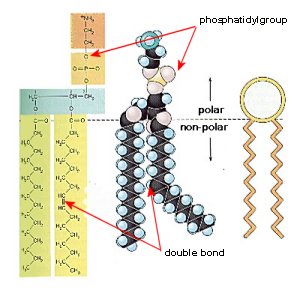Generalities about fats and lipids: Phospholipids
|
Function |
|

|
One of the principal types of lipid in the membrane include the
phospholipids. These have a polar head group and two hydrocarbon tails.
|
Structure |
|

|
An example of a phospholipid is shown in this figure
(right). The top region beginning with the NH3 is the polar group. It is
connected by glycerol to two fatty acid tails. One of the tails is a straight
chain fatty acid (saturated). The other has a kink in the tail because of a cis
double bond (unsaturated).This kink influences packing and movement in the
lateral plane of the membrane.
Phospholipids pack together in two leaflets
in the membrane. The presence of the cis double bonds prevents tight packing
and makes the bilayer difficult to freeze. The lipid bilayer gives the
membranes its fluid characteristics.
At low temperatures, the bilayer is
in a gel state and tightly packed. At higher (body) temperatures, the bilayer
actually "melts' and the interior is fluid allowing the lipid molecules to move
around, rotate, exchange places. This also allows movement of other components
of the membrane. |
 |
| Phospholipid structure |
|
 |
| Membrane with double phospholipid layer |
|
|
Most common phospholipids |
|

|
Phosphoglycerides containing one nitrogenous base:
- Choline glycerophospholipids (PC)
- Ethanolamine glycerophospholipids (PE)
- Serine glycerophospholipids (PS)
- Glycine glycerophospholipids (PG)
Phosphoglycerides containing two glycerol molecules:
- Phosphatidylglycerol
- Diphosphatidylglycerol or Cardiolipin
- Lysobisphosphatidic acid
Phosphoglycerides containing inositol: Phospho-inositides
More details can be found in the amazing pages of the
CyberLipid
Center.
|

